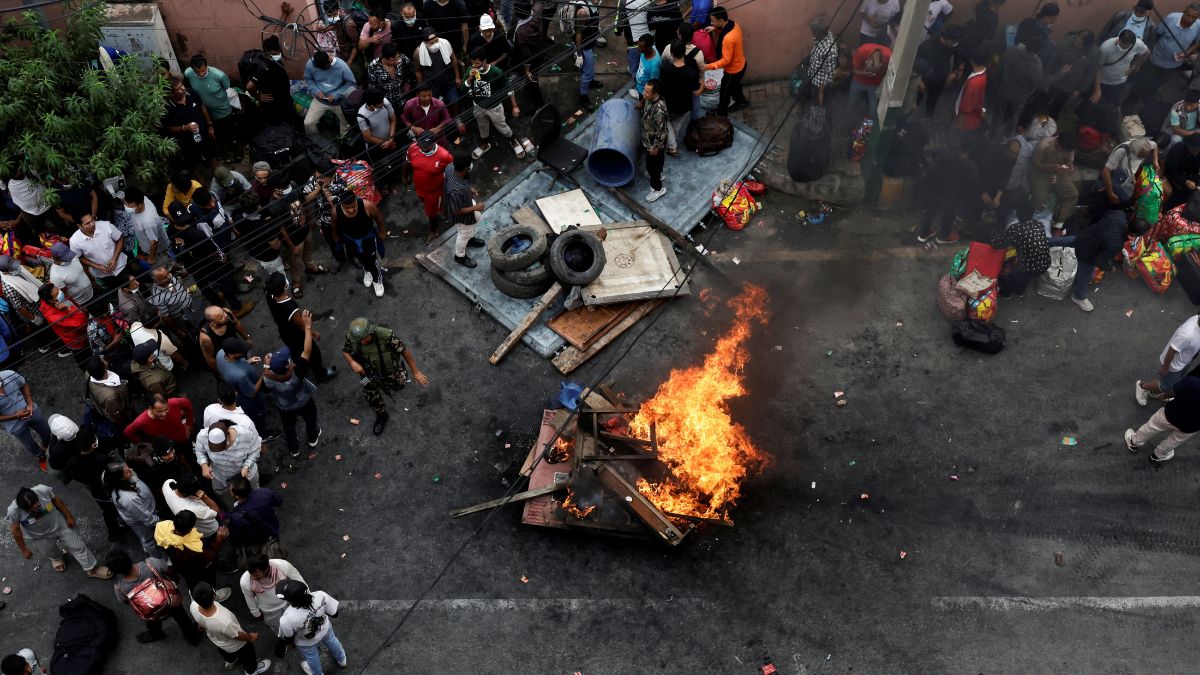A portrait of Nepal’s revered unifier, King Prithvi Narayan Shah, displayed behind Army chief Ashok Raj Sigdel during a national address has set sparked a debate across the Himalayan nation.
On Tuesday evening Sigdel delivered a televised message to the nation. His speech was focused on appealing for calm amid widespread violence.
He urged demonstrators to return looted firearms, promised that the army would safeguard citizens, and stated that dialogue would be pursued to restore order.
However, his remarks were quickly overshadowed by what viewers saw in the background: a portrait of King Prithvi Narayan Shah, the monarch credited with unifying Nepal in the 18th century.
The image immediately became the subject of intense discussion, with many interpreting it as a symbolic message during a time of national instability.
Screenshots of the address spread rapidly across social media platforms, with captions such as “Is this a sign of monarchy’s return?” and “The biggest optic signal that can be given out.”
For royalists, it was seen as a moment of validation. Earlier in 2025, large-scale pro-monarchy demonstrations had taken place across Kathmandu and other cities, demanding that former King Gyanendra Shah be reinstated and that Nepal return to being a Hindu kingdom.
These protests were eventually subdued through curfews and arrests, but the portrait’s sudden appearance has revived momentum among royalist supporters.
While some may view the display as politically charged, it is also a reflection of the army’s deep historical association with Prithvi Narayan Shah. Numerous army institutions, including hospitals, barracks, and training centres, bear his name.
His military reforms are considered foundational to the Nepalese Army’s structure.
Who was King Prithvi Narayan Shah?
The figure at the centereof the recent debate, King Prithvi Narayan Shah, holds a towering place in Nepal’s history.
Born on January 7, 1723, in Gorkha, he became the last ruler of the Gorkha Kingdom and the first king of a unified Nepal. His reign marked a turning point, transforming a fragmented collection of small states into a centralised Himalayan kingdom.
Before his unification campaign, the region that now constitutes Nepal was divided into numerous principalities. There were 52 independent states, collectively known as the Baisi Rajya and Chaubise Rajya.
Additionally, three separate Sen states — Makawanpur, Bijayapur, and Chaudandi — controlled the southeastern Terai plains.
The Kathmandu Valley itself was split among three city-states: Bhaktapur, Kantipur, and Lalitpur. These divisions left the region vulnerable to external threats and internal conflicts.
Prithvi Narayan Shah ascended the Gorkha throne on April 3, 1743, inheriting a small but strategically located kingdom. Determined to expand Gorkha’s influence, he travelled to Varanasi in India to gather intelligence on the political and economic conditions of neighbouring regions.
Varanasi, at the time a major commercial hub, provided him access to merchants, military experts, and regional leaders. During this visit, his father-in-law, a local Thakuri chief named Abhiman Singh, helped him acquire firearms and ammunition, resources that would later play a key role in his military campaigns.
Prithvi Narayan Shah’s first major victory came in 1744 with the capture of Nuwakot, a strategically important area that provided access to trade routes between Tibet and India.
Over the next two decades, his forces systematically brought neighbouring principalities under Gorkha control.
By 1769, he successfully conquered the Kathmandu Valley, uniting the key city-states and establishing Kathmandu as the capital of the new kingdom. He then turned his attention eastward, annexing territories such as Chaudandi and Bijayapur, thereby extending Nepal’s borders from the Tista River in the east to the Chepe River in the west.
His successors later expanded these borders further to include regions such as Kumaon and Garhwal, though this westward push eventually came into conflict with the British East India Company.
One of Prithvi Narayan Shah’s enduring contributions was his transformation of Nepal’s military forces. Initially, Gorkha’s army was small and poorly organised.
Through a series of reforms, he developed a disciplined fighting force equipped with matchlock firearms and trained in guerrilla tactics well-suited to Nepal’s rugged terrain.
By 1762, he had established core military battalions, including Shreenath, Kali Baksh, Barda Bahadur, and Sabuj, drawing recruits from diverse communities such as Gurung, Magar, Chhetri, and Thakuri clans.
At its peak, his army numbered approximately 50,000 soldiers, making it a formidable regional power.
These reforms laid the groundwork for what would later become the modern Nepalese Army.
Even today, several army units and institutions bear his name, including the Prithvi Narayan Shah Army Hospital, underscoring the lasting influence of his military vision.
Prithvi Narayan Shah’s rule was not solely defined by military conquest. He also articulated a political philosophy aimed at preserving Nepal’s sovereignty and promoting national unity.
He famously described Nepal as a “garden of four castes and 36 ethnicities”, highlighting the importance of diversity and coexistence within the kingdom.
This ideal sought to integrate various groups into a shared national identity, a concept that continues to resonate in Nepalese society.
To safeguard Nepal’s independence, he adopted policies designed to limit foreign influence, particularly from the expanding British presence in India.
By sealing Nepal’s borders and tightly regulating trade, he aimed to maintain political autonomy during a period of rapid regional change.
Towards the end of his life, Prithvi Narayan Shah convened a special council known as the bhardaari-sabha. During this meeting, he shared his vision for Nepal’s future with his family and ministers, outlining strategies for governance, defence, and diplomacy.
These discussions were later compiled into a seminal text called the Divyopadesh, which continues to be studied by historians and policymakers.
On January 11, 1775, Prithvi Narayan Shah died at Devighat, Nuwakot, on his 52nd birthday. His son, Pratap Singh Shah, succeeded him, while his younger son, Bahadur Shah, played a key role in continuing the unification campaign.
When did Nepal step down from monarchy?
The abolition of Nepal’s monarchy in 2008, following a decade-long Maoist insurgency, marked the end of centuries of Shah dynasty rule.
King Gyanendra Shah, the last monarch, was forced to step down as Nepal transitioned to a federal democratic republic.
However, Prithvi Narayan Shah remains a revered figure. His contributions are commemorated through statues, military institutions, and public ceremonies.
His vision of unity and sovereignty continues to shape national discourse, especially during times of political instability.
The current unrest has brought his legacy back into focus. Earlier this year, former Maoist guerrilla Durga Prasai, who once opposed the monarchy, led pro-royalist marches demanding the restoration of a Hindu kingdom.
More recently, Prasai has aligned himself with the Gen Z protest movement and has been involved in discussions about Nepal’s political future.
Former King Gyanendra Shah also issued a statement this week, expressing sorrow over the loss of life during the protests. He extended condolences to the families of the deceased and urged young protesters to remain peaceful.
He also cautioned that “external elements” might seek to exploit the crisis for their own ends, but he refrained from explicitly calling for the monarchy’s return.
What is Nepal’s current situation?
Over the past week, the country has been shaken by violent demonstrations, largely led by younger citizens frustrated with entrenched corruption and lack of opportunities.
These demonstrations have come to be known as the “Gen Z protests”, given the predominance of youth participation.
The unrest escalated dramatically on Monday and Tuesday, when protesters stormed and torched key government buildings, including the Supreme Court, ministers’ residences, and the private home of Prime Minister Khadga Prasad Oli.
Several private businesses were also targeted. In Kathmandu, even luxury hotels such as the Hilton were set ablaze, while in Pokhara, one of Nepal’s main tourist hubs, multiple hotels and establishments were destroyed.
The violence and chaos ultimately forced Oli to step down Tuesday, after which the ceremonial head of state, President Ram Chandra Poudel, requested him to continue temporarily as head of a transitional government until a new leadership could be put in place.
However, Oli left his official residence soon after his resignation, and his current location remains unknown.
With no clear successor, the Nepal Army assumed control of Kathmandu to stabilise the situation. A strict curfew was imposed across the capital and surrounding areas.
Discussions are underway regarding who should lead a transitional administration. Protest representatives met with army officials on Wednesday, where some factions advocated for Sushila Karki, a respected former Chief Justice of Nepal, to serve as interim leader.
No official decision has been announced.
The scale of the crisis has been severe. According to Nepal’s health ministry, as of September 11, at least 30 people have been killed in the clashes, while more than 1,033 individuals have been injured.
Schools, colleges, and shops in Kathmandu and neighbouring districts remain shut, though limited essential services have resumed.
With inputs from agencies


)

)
)
)
)
)
)
)
)



